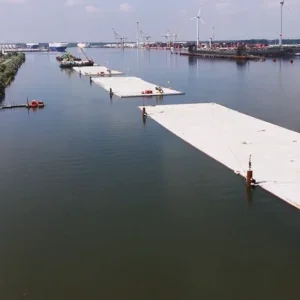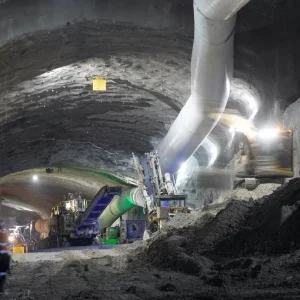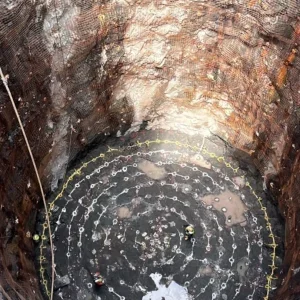Although many other tunnelling methods have been developed in the past 200 years, drill and blast is still the conventional method for non-circular cross-sections. Circular tunnels too short to amortise the high start-up costs of a TBM or too hard to justify the cost of cutter replacement for smaller machines such as roadheaders also use drill and blast. Typically, the blasting cycle comprises the following steps: drilling blast holes and loading with explosives > detonating the blast > ventilating to remove blast fumes > removing the blasted rock (mucking) > scaling crown and walls to remove loosened pieces of rock > installing initial ground support > and advancing rail tracks, ventilation and utilities.
The explosive is generally a chemical compound or mixture ignited by heat, impact, friction or a combination of all three. Upon ignition, it expands very rapidly in a detonation (as opposed to a deflagration, which is slower and occurs for instance with gunpowder). Upon detonation, heat (around 4,500°C) and large quantities of high-pressure gases (typically 250,000 bar) are released. The gases expand with high force to overcome the confining forces of the surrounding rock formation. Common types of explosives include dynamite gelatins, ANFO, slurries and emulsions.
Many factors must be considered in the design of a blasting round. Controlling surface impacts is essential in urban areas. This is accomplished by specifying limits on the pounds of explosive per delay, the sound increase in decibels, the maximum particle velocity at adjacent building foundations, and the permissible air overpressures.
Two parameters are often calculated from a blast design: the ‘powder factor’ or specific charge (kg of explosives per m3 of blasted rock) and the drill factor (total length of drill holes per volume of blasted rock (m/m3)). These are indicators of the overall economy of blasting and permit easy comparison between blast patterns.
The correct blast pattern design ensures the required distribution of the explosive in the rock and achieves the desired result. The blast designer’s main concerns are that the quality of the host rock and the shape of the tunnel, especially the arch, be maintained. Controlled blasting requires closer spacing of the profile (perimeter) holes plus reduced charges in them. Among the construction concerns for the blast engineer in a firing sequence (delay pattern) is the creation of efficient breakage and muck-pile concentration, proper rock fragmentation to facilitate mucking operations, optimised drill-hole diameter, spacing, and burden (measured parallel and perpendicular, respectively, to the momentary free face) and lastly, explosive strengths.
‘Smooth blasting’ is one of the standard methods used in a controlled blast. It involves a line of holes drilled along the walls and arch at closer spacing than the production holes; loaded with lightly lower strength and well-distributed charges, and ‘shot’ on the last delay or two in the production round. Amount of explosive: experienced blasters correctly forecast the weight and quantity of explosive required and optimise it as they observe the operation. The powder factor will vary from about 2Ib/yd3 (1.186kg/m3) for a large opening (ie. more than 1,000 ft2 (93m2)) in soft fractured rock to more than 9Ib/yd3 (5.3kg/m3) for a 100ft2 (9.3m2) drift in hard intact rock. A reliable way to determine blast vibrations (particularly around residential or sensitive industrial areas) is to install a seismograph to verify the severity of vibrations. This will permit field adjustment of loads per delay to the maximum output consistent with negligible damage.
Overbreak is the unintended excavation that occurs outside of the designed excavation line in a tunnel due to the irregular pattern of rock breakage – which often can be unavoidable after the blast. However, it can be minimised by using controlled blasting. The definition of overbreak also relates to the amount of concrete required to fill the over-excavated space in lined tunnels.
As a tunnel or excavation progresses, the roof and side walls need to be supported to stop rock from falling into the excavation. Philosophies and methods for rock support vary widely but typical rock support systems can include rock bolts or rock dowels, shotcrete, ribs or mining arches and lagging, cable bolts, and in-situ concrete.







